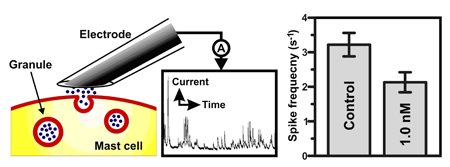03/26/2008
Interaction of Nanoparticles with Biological Cells
Recent research from the group of Professor Christy Haynes.
Nanoscale materials are facilitating novel
biomedical applications in the areas of therapeutics and assay development. Characterizing
the basic interaction of these nanoparticles with biological cells is critical
for data interpretation and further technological development. This
characterization of nanoparticle-cell interaction suffers from a paucity
of analytical chemistry studies and presents interesting measurement challenges
based on the complex biological environment, the dynamic nature of the
nanoparticle-cell interaction, and the high sensitivities required for
single cell assays.
The Haynes group has recently demonstrated
that carbon-fiber microelectrode amperometry can be used to assess critical
cellular function of primary culture immune system cells after nanoparticle
exposure. Gold nanoparticles are the focus of Haynes group studies to date
based on their wide application in the areas of DNA and drug delivery,
direct inhibition of cancer cell proliferation, photodynamic therapy, and
as both intra- and extracellular biomarker probes. The groupsí electron
microscopy and amperometry studies reveal that mast cells, a critical immune
system effector cell, take up gold nanoparticles, these gold nanoparticles
interrupt the granular matrix, and the disrupted matrix triggers abnormal
chemical messenger secretion. Understanding the mechanistic interaction
of the nanoparticle and the intracellular environment will facilitate future
design and fabrication of non-cytotoxic nanoscale materials.

|